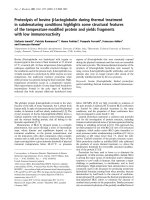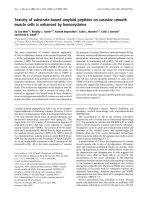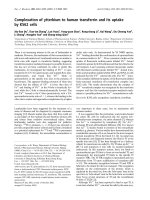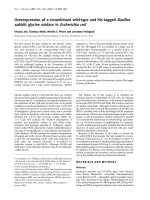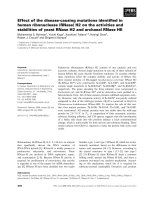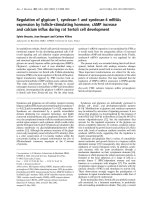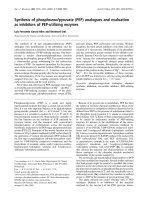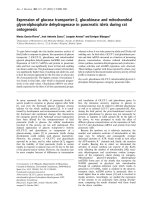Báo cáo y học: "Coaggregation of Fc RI with Fc RIIB Inhibits Degranulation but Not Induction of Bcl-2 Family Members A1 and Bim in Mast Cells" ppsx
Bạn đang xem bản rút gọn của tài liệu. Xem và tải ngay bản đầy đủ của tài liệu tại đây (725.12 KB, 11 trang )
87
Mast cells are critical effector cells mediating
immunoglobulin E (IgE)–dependent allergic
responses. Binding of an allergen to IgE, already
bound to its high-affinity receptor Fc
⑀RI on mast
cells, leads to aggregation and subsequent acti-
vation. This initiates signalling events that typically
result in degranulation, changes in gene expres-
sion, and the release of inflammatory mediators,
contributing to acute and late-phase allergic
responses.
1–3
Fc⑀RI consists of a tetrameric pro-
tein complex, the IgE-binding amplifying
␣ chain,
a signalling
 chain, and two ␥ chains.
4
The  and
␥ subunits of the Fc⑀RI each contain an immunore-
ceptor tyrosine-based activation motif (ITAM),
which is phosphorylated upon Fc
⑀RI aggregation
and which is both necessary and sufficient for
receptor-induced signal transduction.
5
Mast cells also express other Fc receptors,
either constitutively or upon stimulation; among
these, Fc
␥RI (CD64), Fc␥RIIB (CD32), and
Fc
␥RIII (CD16) are receptors for immunoglobu-
lin G (IgG). Fc
␥RI (high-affinity IgG receptor)
and Fc
␥RIII (low-affinity IgG receptor) are acti-
vating receptors, both containing ITAM, that ini-
tiate signalling upon aggregation.
6,7
Fc␥RIIB is a
low-affinity receptor containing an immunore-
ceptor tyrosine-based inhibitory motif (ITIM),
8
which negatively regulates the activating signal
when coaggregated with activating receptors bear-
ing an ITAM.
9
The coaggregation results in the
Original Article
Coaggregation of Fc⑀RI with Fc␥RIIB Inhibits
Degranulation but Not Induction of Bcl-2
Family Members A1 and Bim in Mast Cells
Maria Ekoff, MSc; Christine Möller, PhD; Zou Xiang, PhD; Gunnar Nilsson, PhD
Abstract
The aggregation of high-affinity immunoglobulin E (IgE) receptors (Fc⑀RI) on mast cells is a critical event
in the initiation of an allergic reaction. Coengagement of Fc⑀RI with immunoglobulin G (IgG) low-affinity
receptor Fc␥RIIB/CD32 inhibits degranulation and the release of inflammatory mediators from mast cells
and has therefore been proposed as a new therapeutic approach for the treatment of allergies. In this
study, we investigated whether Fc␥RIIB, besides inhibiting degranulation, negatively regulates other sig-
nalling pathways downstream of Fc⑀RI. For this, we determined the phosphorylation and/or expression
of proteins involved in the regulation of mast-cell apoptosis. Coaggregation led to an attenuation of Akt
phosphorylation but did not inhibit phosphorylation of transcription factor Foxo3a or its proapoptotic tar-
get, Bim. Similarly, Fc⑀RI-dependent expression of the prosurvival gene A1 was not affected by coag-
gregation. Our data demonstrate that coengagement of Fc⑀RI and Fc␥RIIB inhibits degranulation but
not the signalling pathways regulating Bcl-2 family members Bim and A1.
M. Ekoff, C. Möller, G. Nilsson—Department of
Medicine, Clinical Immunology and Allergy Unit,
Karolinska Institutet, Stockholm, Sweden; Z. Xiang—
Cambridge Institute for Medical Research, Cambridge,
United Kingdom
Correspondence to: Dr. Gunnar Nilsson, Karolinska
Institutet, Department of Medicine, Clinical Immunology
and Allergy Unit, KS L2:04, SE-171 76 Stockholm,
Sweden; E-mail:
DOI 10.2310/7480.2006.00011
88 Allergy, Asthma, and Clinical Immunology / Volume 2, Number 3, Fall 2006
recruitment of the inhibitory signalling molecule
SHIP, leading to the abrogation of the ITAM-
induced activation.
2,10,11
IgE-induced mast cell activation (ie, Fc⑀RI
aggregation) is negatively regulated by coaggre-
gation of Fc
⑀RI with Fc␥RIIB.
9,12
The release of
mediators and cytokines is inhibited in a process
in which Fc
⑀RI contributes to the ITIM-dependent
inhibition of its own intracellular signalling. This
is achieved by the Fc
⑀RI-associated tyrosine kinase
Lyn, which phosphorylates the Fc
␥RIIB ITIM
that recruits SHIP1, thus leading to Fc
⑀RI signal
abrogation.
11,13,14
The receptors interact with the F-
actin skeleton that enables Fc
␥RIIB to recruit
SHIP1, which is provided by filamin-1. Fc
␥RIIB
is believed to negatively regulate Fc
⑀RI signalling
in two ways: by facilitating the translocation of
Fc
⑀RI into the F-actin skeleton but also by con-
centrating SHIP1 at the site close to Fc
⑀RI.
15
Investigations of the mechanism by which SHIP
mediates its Fc
␥RIIB inhibitory function have
also suggested p62
dok
as a possible mediator of
Fc
␥RIIB inhibition of Fc⑀RI signalling down-
stream of SHIP in mast cells.
16
Fc⑀RI-mediated degranulation and release of
mediators are inhibited when Fc
⑀RI is coaggre-
gated with Fc
␥RIIB.
12
In addition to elucidating
the impact of coaggregation on mast-cell degranu-
lation, this study has elucidated the effect on the acti-
vation of downstream signalling pathways involved
in the regulation of mast-cell survival. The aggre-
gation of Fc
⑀RI induces rapid but transient phos-
phorylation of the signalling protein Akt and the fork-
head transcription factor Foxo3a, known to regulate
Bim expression at the transcriptional level.
17
Phos-
phorylated Akt phosphorylates and thereby inacti-
vates Foxo3a, which in its unphosphorylated state
is located in the nucleus and acts as a transcription
factor for Bim. Bim is a proapoptotic protein of the
Bcl-2 family, involved in the regulation of mast-cell
apoptosis.
18,19
Another Bcl-2 family member of cru-
cial importance for Fc
⑀RI-mediated activation-
induced mast-cell survival is A1.
20
Mast cells lack-
ing A1 do not survive IgE receptor aggregation.
20
In this study, we investigated if Fc⑀RI-
mediated activation/expression of Akt, Foxo3a,
Bim, and A1 are inhibited when Fc
⑀RI is coen-
gaged with Fc
␥RIIB. We report here that although
mast-cell degranulation is inhibited and the phos-
phorylation of Akt is attenuated by the coaggre-
gation of Fc
⑀RI with Fc␥RIIB, Foxo3a and Bim
are still phosphorylated and up-regulated, respec-
tively. We also demonstrate that the level of A1
messenger ribonucleic acid (mRNA) induced by
Fc
⑀RI is not significantly altered upon coaggre-
gation with Fc
␥RIIB. Altogether, this indicates that
only certain signalling pathways are affected by
the coaggregation of Fc
⑀RI with Fc␥RIIB whereas
others, closely related to cell survival, remain
largely unaffected.
Materials and Methods
Mast-Cell Cultures
The murine mast cell line C57
21
(kindly
provided by Dr. S.J. Galli, Stanford University,
Stanford, CA) was cultured in RPMI-1640 medium
supplemented with 10% fetal bovine serum
(FBS), 2 mM of
L-glutamine, 100 µg/mL of peni-
cillin/streptomycin, and 50 µM of 2-mercap-
toethanol. All culture reagents were obtained from
Sigma Chemical Co. (St. Louis, MO). The C57
mast cell line has previously been characterized
for Fc
␥RII/Fc␥RIII expression.
22
Antibodies and Reagents
AffiniPure rabbit anti-mouse IgG (RAM IgG),
AffiniPure RAM IgG F(ab´)
2
fragment (RAM
F(ab´)
2
), and AffiniPure mouse anti-rat IgG (H+L)
F(ab´)
2
fragment (MAR F(ab´)
2
) were all purchased
from Jackson ImmunoResearch Laboratories, Inc.,
Baltimore, MD. Purified RAM CD16/CD32
(Fc
␥III/II receptor) monoclonal antibody (2.4G2
rat Ab) was obtained from BD Biosciences, Hei-
delberg, Germany. Anti-rabbit IgE horseradish per-
oxidase–linked donkey anti-rabbit antibody was
obtained from Amersham Biosciences, Uppsala,
Sweden. LumiGLO reagent and peroxide, 10
ϫ cell
lysis buffer, antibodies directed against phospho-Akt
(serine [Ser] 473 and threonine [Thr] 308), and Akt
were purchased from Cell Signaling Technology,
Beverly, MA. Antibodies directed against phospho-
Foxo3a (Thr 32 and Ser 253) and Foxo3a were
Coaggregation of Fc⑀RI with Fc␥RIIB in Mast Cells — Ekoff et al 89
obtained from Upstate Biotechnology, Lake
Placid, NY. Anti-Bim antibody was purchased
from Affinity Bioreagents, Inc., Golden, CO.
4
ϫ NuPAGE LDS Sample Buffer and 10ϫ
NuPAGE Sample Reducing Agent were obtained
from Invitrogen, Carlsbad, CA; TriPure Isola-
tion Reagent was purchased from Boehringer
Mannheim, Mannheim, Germany; and Tween 20
was obtained from Merck Schuchardt, Hohen-
brunn, Germany. All other reagents were pur-
chased from Sigma Chemical Co.
Antibody Conjugation
MAR F(ab´)2 was trinitrophenylated by incuba-
tion for 2 hours at room temperature with picryl-
sulfonic acid (2,4,6-trinitrobenzene sulfonic acid
in borate-buffered saline, pH 8.0). The TNP
7
-
F(ab´)2 MAR obtained was purified on a
prepacked disposable PD-10 column containing
Sephadex G-25 medium (Amersham Biosciences).
Mast-Cell Activation
Mast _cells to be used for ribonuclease (RNAse)
protection assay and
␣-hexosaminidase release
assay were resuspended in RPMI-1640 medium
supplemented with 0.2% bovine serum albumin,
2 mM of L-glutamine, and 100 µg/mL of peni-
cillin/streptomycin. The cells were sensitized for
90 minutes at 37°C by the addition of 0.1 µg/mL
of monoclonal anti-dinitrophenyl (anti-DNP) clone
SPE-7 IgE mouse antibody (anti-DNP IgE). After
washing, the cells were activated by the addition
of either 45 µg/mL of RAM IgG (coaggregation
of Fc
⑀RI with Fc␥RIIB) or 30 µg/mL of RAM
F(ab´)
2
(aggregation of Fc⑀RI) at 37°C for the
time periods indicated. Mast cells to be used for
Western blot analysis were resuspended in the
previously mentioned medium. The cells were
sensitized for 90 minutes at 37°C by the addition
of 0.1 µg/mL of the same IgE as previously men-
tioned or 0.1 µg/mL of the same IgE together with
5 µg/mL of 2.4G2 rat Ab. After being washed, the
cells were activated by the addition of 10 µg/mL
of TNP7-F(ab´)
2
mouse anti-rabbit (MAR) at
37°C, causing either coaggregation of Fc
␥RIIB
with Fc
⑀RI or aggregation of Fc⑀RI, for the time
periods indicated. The conjugated antibody, TNP7-
MAR F(ab´)
2
, functions as a multivalent antigen
recognized by the Fc
⑀RI-bound IgE but also rec-
ognizing bound 2.4G2 rat Ab.
13
Aggregation with
2.4G2 rat Ab together with TNP7-MAR F(ab´)
2
does not cause degranulation, which indicates that
expression of Fc
␥RIII (an activating low-affinity
receptor for IgG) on C57 cells does not interfere
with our system (data not shown). In experiments
in which the phosphorylation pattern of Akt and
Foxo3a as well as the total amount of these two
proteins were measured, the mast cells were starved
for approximately 24 hours at 37°C in RPMI-
1640 medium supplemented with 0.5% FBS before
sensitization and activation. For Bim expression
experiments, the mast cells were resuspended in
RPMI-1640 medium supplemented with 10% fil-
tered FBS, 2 mM of L-glutamine, 100 µg/mL of
penicillin/streptomycin, and 50 µM of 2-mercap-
toethanol during both sensitization and activa-
tion, which lasted for 24 hours.
N-Acetyl-

-D-Hexosaminidase Release Assay
For detection of the granular enzyme -hex-
osaminidase, an enzymatic colorimetric assay was
used.
23
After 30 minutes of activation, 60 µL of
supernatant were transferred to a 96-well plate
and mixed with an equal volume of substrate solu-
tion (7.5 mM of p-nitrophenyl-N-acetyl-
-D-glu-
cosaminide dissolved in 80 mM of citric acid, pH
4.5). The mixture was incubated on a rocker plat-
form for 2 hours at 37°C. After incubation, 120 µL
of glycine (0.2 M, pH 10.7) was added to each well,
and the absorbance was measured with an Emax
Precision Microplate Reader (Molecular Devices,
Sunnyvale, CA).
Western Blot Analysis
The cells were lysed in SDS sample buffer (125
mM of tris-hydrochloric acid [pH 6.8], 4% w/v
SDS, 20% glycerol, 0.02% w/v bromphenol blue,
and 50 mM of dithiothreitol, added just before use)
or in cell lysis buffer (1
ϫ cell lysis buffer, 1 mM
of phenylmethylsulfonyl fluoride [PMSF]) before
being sonicated on ice. The phosphorylation and/or
the total amount of proteins of interest were stud-
ied by Western blot with a NuPAGE Bis-Tris
Western gel (Invitrogen, Carlsbad, CA). After
electrophoresis, the proteins were electrically
transferred to a nitrocellulose membrane (Hybond
ECL, Amersham Biosciences). All was performed
according to the manufacturers´ instructions. The
membrane was incubated overnight at 4°C with the
primary antibody and thereafter incubated with
horseradish peroxidase–conjugated secondary
antibody for 1 hour at room temperature. The pro-
teins were visualized with an enhanced chemilu-
minescence system (LumiGLO) and exposure to
a Hybond ECL film.
RNAse Protection Assay
TriPure isolation reagent was used for isolation of
total cellular ribonucleic acid (RNA). An RNAse
protection assay (RPA) was performed (according
to RiboQuant System protocol) with an mAPO-2
multiprobe set (PharMingen, San Diego, CA). The
gel was dried and exposed on Kodak film (East-
man Kodak Company, Rochester, NY) with inten-
sifying screens at –70°C. Expression of RNA was
detected with a phosphoimager device, and levels
of expression were quantified with
MacBAS 2.2
software (Fuji Photo Film Co., Ltd., Tokyo, Japan).
Statistical Analysis
We used an analysis of variance, followed by mul-
tiple comparison with the Wilcoxon matched-
pairs test.
Results
Coaggregation of Fc⑀RI with Fc␥RIIB
Inhibits IgE-Dependent Mast-Cell
Degranulation
To analyze the effect of Fc␥RIIB-mediated inhi-
bition of mast-cell activation, we used murine
C57 mast cells known to express the receptors
Fc
⑀RI and Fc␥RIIB. C57 cells were sensitized
with murine IgE and challenged with polyclonal
RAM F(ab´)
2
to aggregate Fc⑀RI or with RAM IgG
to coaggregate Fc
⑀RI and Fc␥RIIB. The RAM
F(ab´)
2
induced activation of mast cells, leading
to degranulation as measured by
-hexosaminidase
release (Figure 1A). When Fc
⑀RI was coaggre-
gated with Fc
␥RIIB by the addition of RAM IgG,
the release of
-hexosaminidase was inhibited
(see Figure 1A).
In addition to the activation system whereby RAM
IgG or RAM F(ab´)
2
was added, we also used
another system for Western blot analysis, one by
which each receptor can be aggregated separately
or coaggregated. C57 cells were sensitized with
murine anti-DNP IgE and incubated with or with-
out 2.4G2 rat Ab before challenge with TNP-
MAR F(ab´)
2
, TNP-conjugated F(ab´)
2
fragments
of mouse anti-rat IgG. The conjugated antibody,
TNP7-MAR F(ab´)
2
, functions as a multivalent
antigen recognized by the Fc
⑀RI-bound IgE but
also recognizing Fc
␥RII-bound 2.4G2 rat Ab.
13
The
addition of TNP7-MAR F(ab´)
2
will aggregate
Fc
⑀RI in cells sensitized with IgE, aggregate
Fc
␥RIIB in cells sensitized with 2.4G2 rat Ab, and
(as a consequence) coaggregate Fc
⑀RI and
Fc
␥RIIB in cells sensitized with both IgE and
2.4G2 rat Ab. Since aggregation using 2.4G2 rat
Ab together with TNP7-MAR F(ab´)
2
does not
cause degranulation, this indicates that expres-
sion of Fc
␥RIII (an activating low-affinity recep-
tor for IgG) on C57 cells does not interfere with
our system (data not shown). Although not as suf-
ficient as the other system for causing degranula-
tion, this system induced the activation of mast
cells, causing degranulation, and showed inhibi-
tion upon coaggregation of Fc
⑀RI with Fc␥RIIB
(see Figure 1B).
Phosphorylation of Akt Is Attenuated by
Coaggregation of Fc
⑀RI with Fc␥RIIB
To assess the effects of coaggregating Fc⑀RI with
Fc
␥RIIB on signals transduced downstream of
Fc
⑀RI, the phosphorylation pattern of Akt protein
was investigated. Akt is a signal-transducing pro-
tein downstream of PI3-kinase, involved in a
variety of cellular functions such as survival and
90 Allergy, Asthma, and Clinical Immunology / Volume 2, Number 3, Fall 2006
metabolism.
24,25
Via 3-phosphoinositide–depen-
dent protein kinases, the PI3-kinase can activate
Akt by phosphorylation at three different sites, two
of which—threonine 308 (Thr 308) and serine 473
(Ser 473)—were investigated in this report. We
compared the pattern of Akt phosphorylation at
the Thr 308 and Ser 473 sites in cell lysates after
Fc
⑀RI aggregation or coaggregation of Fc⑀RI
with Fc
␥RIIB. Fc⑀RI aggregation induced rapid
phosphorylation of Akt at Thr 308; the maximum
phosphorylation stage was reached within 1
minute, and phosphorylation decreased at 5 min-
utes. The phosphorylation of Akt after Fc
⑀RI
aggregation at Ser 473 was achieved within 1
minute and remained at a comparable level for 10
minutes before decreasing at 30 minutes (Figure
2). Considerable reductions of Akt phosphoryla-
tion at Thr 308 and Ser 473 were observed as early
as 1 minute after coaggregation of Fc
⑀RI with
Fc
␥RIIB (see Figure 2).
Coaggregation of Fc⑀RI with Fc␥RIIB Does
Not Affect the Phosphorylation of
Transcription Factor Foxo3a
Phosphorylated Akt phosphorylates and thereby
inactivates the forkhead protein Foxo3a.
26
The
phosphorylation of Foxo3a prevents its translo-
cation into the nucleus, where it acts as a tran-
scription factor for certain genes. We investigated
the phosphorylation of Foxo3a at sites Ser 253 and
Thr 32. Phosphorylation of Foxo3a at Ser 253
occurred within 1 minute but reached background
phosphorylation level again after 30 minutes (Fig-
ure 3). However, after rapid phosphorylation at site
Thr 32 within 1 minute after Fc
⑀RI aggregation,
phosphorylation remained constant until 30 min-
utes had elapsed (see Figure 3). In contrast to the
effect on Akt phosphorylation, coengagement of
Fc
⑀RI with Fc␥RIIB did not affect either the lev-
els of phosphorylation or the duration of the Fc
⑀RI-
induced Foxo3a phosphorylation (see Figure 3).
Coaggregation of Fc⑀RI with Fc␥RIIB in Mast Cells — Ekoff et al 91
Figure 1 Inhibition of IgE-mediated mast-cell degranulation by Fc␥RIIB. A, Mast cells were sensitized with 0.1
µg/mL of monoclonal anti-dinitrophenyl (anti-DNP) clone SPE-7 immunoglobulin E (IgE) mouse antibody (anti-
DNP IgE) before being challenged with 30µg/mL of rabbit anti-mouse (RAM) F(ab’)
2
or 45µg/mL of RAM
immunoglobulin G (IgG) for 30 minutes. Resting cells or cells incubated with 0.1 µg/mL of anti-DNP IgE served
as a background control. The figure represents mast-cell activation estimated by -hexosaminidase release as mea-
sured by absorbance. B, Mast cells were sensitized with 0.1 µg/mL of monoclonal anti-DNP clone SPE-7 IgE mouse
antibody (anti-DNP IgE) and preincubated with or without 5 µg/mL of RAM CD16/CD32 (Fc␥III/II receptor) mon-
oclonal antibody (2.4G2 rat Ab), before challenge with 10 µg/mL of TNP-F(ab’)
2
mouse anti-rat (MAR) for 30 min-
utes. Cells incubated with 0.1 µg/mL of anti-DNP IgE or 0.1 µg/mL of anti-DNP IgE and 5 µg/mL of 2.4G2 rat Ab
served as a background control (n = 6; results are presented as mean ± standard error of the mean). *p < .05.
Fc⑀RI-Induced Expression of Bim Is Not
Inhibited by Coaggregation with Fc
␥RIIB
A key regulator of apoptosis is the Bcl-2 family
of proteins, which consists of proapoptotic and
antiapoptotic proteins. Bim, one of the proapop-
totic members, is transcriptionally regulated by
Foxo3a,
27
and we recently showed that Bim is
involved in the regulation of mast-cell apopto-
sis.
18,19
Furthermore, Bim is induced upon aggre-
gation of Fc
⑀RI.
18
Therefore, we next investi-
gated if coaggregation of Fc
⑀RI with Fc␥RIIB
would have an effect on Bim expression. After
Fc
⑀RI aggregation and coaggregation of Fc⑀RI
and Fc
␥RIIB, respectively, the two isoforms of
Bim (Bim
EL
and Bim
L
) were up-regulated to sim-
ilar levels (Figure 4). Bim
EL
consisted of two
bands, owing to a shift in band motility; this shift
of the Bim
EL
band is probably the result of phos-
phorylation.
19,28
The results herein demonstrate
that Bim induced by Fc
⑀RI aggregation is not
affected by coaggregation with Fc
␥RIIB (see
Figure 4).
Coaggregation of Fc⑀RI with Fc␥RIIB Does
Not Affect the Induction of A1
Apoptosis is regulated by members of the Bcl-2 fam-
ily. A1, one of the antiapoptotic Bcl-2 family mem-
bers, is described as being important for the survival
of mast cells during allergic reactions.
20
To deter-
mine whether the coaggregation of Fc
⑀RI with
Fc
␥RIIB affects the induced transcriptional regu-
92 Allergy, Asthma, and Clinical Immunology / Volume 2, Number 3, Fall 2006
Figure 2 Reduction of
immunoglobulin E (IgE)–depen-
dent phosphorylation of Akt by
Fc␥RIIB. C57 mast cells were acti-
vated as in Figure 1B for the indi-
cated periods of time. Cell lysates
were prepared, and the phospho-
rylation of Akt was analyzed by
Western blot with the indicated
antibodies. The result is represen-
tative of three independent exper-
iments. Ser = serine; Thr = threo-
nine; 2.4G2 Ab = anti-mouse
CD16/CD32 (Fc␥III/II receptor)
monoclonal antibody.
Figure 3 Phosphorylation of Foxo3a
induced by Fc⑀RI and Fc␥RIIB or by
Fc⑀RI alone. C57 mast cells were
activated as in Figure 1B for the
indicated periods of time. Cell
lysates were prepared, and the phos-
phorylation of Foxo3a was analyzed
by Western blot with the indicated
antibodies. The result is represen-
tative of three independent experi-
ments. Ser = serine; Thr = threo-
nine; 2.4G2 Ab = anti-mouse
CD16/CD32 (Fc␥III/II receptor)
monoclonal antibody.
lation of A1, an RPA was performed. A1 was absent
in cells incubated only with IgE but was substan-
tially up-regulated after Fc
⑀RI aggregation, as well
as in cells where Fc
⑀RI had been coaggregated
with Fc
␥RIIB for 6 hours (Figure 5). The A1 mRNA
level in cells activated by Fc
⑀RI aggregation had
increased 12-fold, and coaggregation of Fc
␥RIIB
with Fc
⑀RI led to a ninefold increase when the sig-
nal was compared to control cells incubated with
IgE alone (see Figure 5). Thus, although A1 up-reg-
ulation is slightly reduced after the coaggregation
of Fc
⑀RI with Fc␥RIIB when compared to Fc⑀RI
aggregation, the induction of A1 in cells after either
coaggregation of Fc
⑀RI with Fc␥RIIB or Fc⑀RI
aggregation (as compared to resting cells) was con-
sistent in several experiments.
Discussion
Although coaggregation of Fc⑀RI with Fc␥RI is
known to inhibit mast-cell degranulation, the effect
of coaggregation on other signalling pathways in
mast cells has not been investigated previously. In
this study, we found that even though coaggrega-
tion of Fc
⑀RI with Fc␥RIIB inhibits degranulation
and decreases the phosphorylation of Akt, we
observed no effect on Foxo3a phosphorylation or
Bim expression (see Figures 2, 3, and 4). Results
from RPAs showed that the mRNA of A1 (an
antiapoptotic Bcl-2 family member) was up-reg-
ulated both when mast cells were activated through
Fc
⑀RI aggregation and when they were activated
through coaggregation of Fc
⑀RI with Fc␥RIIB
(see Figure 5). Thus, Fc
␥RIIB inhibits some but
not all signalling pathways downstream of Fc
⑀RI.
One pathway affected by Fc
⑀RI aggregation
is the PI3-K pathway, where PI3-K is phospho-
rylated and thereby activated.
5
Activated PI3-K
can, via 3-phosphoinositide–dependent protein
kinases or specific lipid products, phosphorylate
the protein Akt.
29,30
Phosphorylation of Ser 473
and/or Thr 308 enables Akt to carry out its mul-
tifunctional activities, which are involved in a
variety of cellular functions such as survival and
metabolism.
24,25,31,32
Akt became rapidly phos-
phorylated at the two sites that were investigated
after Fc
⑀RI aggregation. The phosphorylation at
Thr 308 was clearly diminished already after 5
minutes whereas the phosphorylation of Ser 473
remained for at least 20 minutes. This difference
in phosphorylation between the two sites might
reflect a strict regulation of phosphorylation of Akt.
Coaggregation of Fc⑀RI with Fc␥RIIB in Mast Cells — Ekoff et al 93
Figure 4 Expression of Bim induced by Fc⑀RI and
Fc␥RIIB or by Fc⑀RI alone. C57 mast cells were acti-
vated as in Figure 1B for 24 hours. Cells sensitized only
with 0.1 µg/mL of anti-dinitrophenyl immunoglobulin
E (lgE) and incubated with or without 5 µg/mL of rab-
bit anti-mouse CD16/CD32 (Fc␥III/II receptor) mon-
oclonal antibody (2.4G2 rat Ab) were used as con-
trols. Cell lysates were prepared, and the induction of
Bim was analyzed by Western blot with the indicated
antibodies. The result is representative of three inde-
pendent experiments. MAR = mouse anti-rat; TNP =
trinitrophenyl. .
Figure 5 A1 expression induced by Fc⑀RI and Fc␥RIIB
or by Fc⑀RI alone. A ribonuclease protection assay
was performed on ribonucleic acid isolated from C57
cells activated as in Figure 1A for 6 hours, and quan-
tifications of A1 transcript levels are shown relative to
their corresponding levels GAPDH housekeeping gene.
Data shown are representative of three separate exper-
iments. IgE = immunoglobulin E; IgG = immunoglob-
ulin G; RAM = rabbit anti-mouse.
After coaggregation of Fc⑀RI with Fc␥RIIB, the
phosphorylation of Akt was attenuated when com-
pared to Fc
⑀RI aggregation. Akt is more heavily
phosphorylated after Fc
⑀RI aggregation, but the
duration of the phosphorylation does not change
after coaggregation of Fc
⑀RI with Fc␥RIIB. These
data are in line with data from earlier studies
showing that coaggregation of Fc
␥RIIB and the
B-cell receptor (as well as coaggregation with the
receptor for stem-cell factor Kit, present on mast
cells) affects the PI3-K pathway and thereby
inhibits the activation of Akt.
33,34
Members of the transcription factor forkhead
family, such as Foxo3a, can be inactivated through
phosphorylation by activated Akt.
26
We found that
Fc
⑀RI aggregation and Fc⑀RI coaggregation with
Fc
␥RII result in the same phosphorylation pattern
of Foxo3a. This is an interesting observation
because one might expect the phosphorylation of
Foxo3a to decrease in response to less phospho-
rylated Akt being available. A possible explana-
tion is that because the phosphorylation of Akt is
not totally abrogated, there might still be enough
to phosphorylate Foxo3a to the same extent.
Another interesting feature is that phosphorylated
Foxo3a is present in cells that are not activated by
either Fc
⑀RI aggregation or coaggregation of
Fc
␥RIIB with Fc⑀RI. This suggests a natural equi-
librium between phosphorylated and unphospho-
rylated Foxo3a in the cells, which is shifted toward
phosphorylation upon activation. Akt is a major
effector protein, and although the phosphorylation
of Foxo3a by Akt does not seem to be affected, a
pathway (or pathways) other than the one inves-
tigated might be where the inhibition of Akt phos-
phorylation plays a more crucial role.
A protein known to be under the transcriptional
control of the forkhead transcription factor Foxo3a
is Bim.
27
We previously found Bim to be strongly
increased upon Fc
⑀RI aggregation.
18
After coag-
gregation of Fc
␥RIIB with Fc⑀RI or after Fc⑀RI
aggregation, the two isoforms of Bim (BimEL
and Bim
L
) were up-regulated in comparison to
unactivated control cells. The results demonstrate
that Fc
⑀RI-induced Bim up-regulation is not
affected upon coaggregation with Fc
␥RIIB. Bim
EL
consisted of two bands, probably due to phos-
phorylation. We have previously seen that stem-
cell factor (SCF) promotes the survival of mast
cells through inactivation of Foxo3a, preventing
the up-regulation of Bim and leading to increased
phosphorylation of Bim. Those results show that
inhibition of Foxo3a and (consequently) Bim pro-
vides an important mechanism by which SCF acts
to prevent apoptosis in mast cells.
19
Antiapoptotic members of the Bcl-2 family
are needed for cell survival. One of the murine pro-
survival Bcl-2 family members is A1, which plays
a prominent role in preventing apoptosis in a
variety of cell systems.
35,36
Previously, we demon-
strated that mRNA levels for A1 are increased after
Fc
⑀RI aggregation and that A1 is critical for the
activation-induced survival of mast cells.
20
Sim-
ilarly, the human homologue bfl-1 is up-regu-
lated in human mast cells upon Fc
⑀RI aggrega-
tion.
37
We examined the mRNA induction of the
antiapoptotic A1 protein after coaggregation of
Fc
⑀RI with Fc␥RIIB; we found that A1 mRNA
was up-regulated both when mast cells are acti-
vated through Fc
⑀RI aggregation and when Fc⑀RI
is coaggregated with Fc
␥RIIB. Our finding that
both antiapoptotic A1 and proapoptotic Bim pro-
teins are up-regulated as a result of Fc
⑀RI aggre-
gation could be an explanation of why this acti-
vation results in cell death or survival in some
experimental settings, since the fate of cells is
likely to be influenced by the relative balance of
these molecules.
The only treatment of allergic diseases that
leads to long-lasting effects is allergen-specific
immunotherapy. The immunologic mechanisms
responsible for a successful treatment are still not
fully defined. One hypothesis is that the antigen-
specific IgG that increases in serum during treat-
ment blocks antibodies,
38
leading to possible coag-
gregation of Fc
⑀RI with Fc␥RIIB. The finding
that allergic activity is inhibited by coaggregating
Fc
⑀RI with Fc␥RIIB by using a human Fc␥-Fc⑀
fusion protein highlights a new promising thera-
peutic approach to immunomodulation.
39
The
fusion protein showed antiallergic effects both in
vitro and in vivo and was shown to inhibit IgE-
mediated activation of blood basophils and cord
blood–derived mast cells.
40
Furthermore, evidence for negative regula-
tion of allergic responses by Fc
␥RIIB has been
94 Allergy, Asthma, and Clinical Immunology / Volume 2, Number 3, Fall 2006
demonstrated by the use of Fc␥RIIB-deficient
mice. These mice produce more immunoglobu-
lin than wild-type mice in response to immu-
nization,
41
in which this increase is partly due to
the increase in IgG1. The negative regulation of
IgG production by Fc
␥RIIB probably decreases
the production of IgE. This would work in favour
of reduced Fc
⑀RI expression on the cells and
less IgE being available for activation.
42,43
Fc␥RIIB-deficient mice also display more vas-
cular permeability in the IgG-dependent passive
cutaneous anaphylaxis reaction than do wild-
type mice, indicating mast-cell activation of a
greater extent than that seen in wild-type mice.
41
During IgE- and IgG-dependent passive sys-
temic anaphylaxis, the Fc
␥RIIB-deficient mice
undergo increased hypothermia and death.
44
These
findings indicate an important role for Fc
␥RIIB
on mast cells in down-regulating immediate
hypersensitivity reactions as a result of anaphy-
lactic mast-cell activation.
This report shows that although mast-cell
degranulation is inhibited by coaggregation of
Fc
⑀RI with Fc␥RIIB, other downstream signalling
proteins that are closely related to cell survival
remain largely unaffected. Figure 6 presents a
schematic overview of how these processes could
be separated in the cell. Our previous finding that
both proapoptotic and antiapoptotic proteins are
up-regulated as a result of Fc
⑀RI aggregation sug-
gests that the fate of cells is likely to be based on
the balance between these proteins.
17
Acknowledgements
The authors would like to thank Dr. Marc Daëron
for helpful discussions and advice, Prof. Birgitta
Heyman and Mrs. Imma Brogren for help in the
production of conjugated antibody, and Prof.
Stephen Galli for C57 cells.
This work was supported by the Swedish
Research Council-Medicine; the Swedish Cancer
Foundation; the Bror Hjerpstedts Foundation; the
Consul Th. C. Berghs Foundation; the Swedish
Cancer and Allergy Fund; Ollie and Elof Ericsson’s
Foundation; King Gustav V’s 80 Years Foundation;
the Ellen, Walter, and Lennart Hesselmans Foun-
dation; and the Karolinska Institutet.
References
1. Metcalfe DD, Baram D, Mekori YA. Mast cells.
Physiol Rev 1997;77:1033–79.
2. Daeron M. Fc receptor biology. Annu Rev
Immunol 1997;15:203–34.
3. Ott VL, Cambier JC. Activating and inhibitory
signaling in mast cells: new opportunities for
therapeutic intervention? J Allergy Clin Immunol
2000;106:429–40.
4. Blank U, Ra C, Miller L, et al. Complete struc-
ture and expression in transfected cells of high
affinity IgE receptor. Nature 1989;337:187–9.
5. Turner H, Kinet JP. Signalling through the high-
affinity IgE receptor Fc epsilonRI. Nature
1999;402(6760 Suppl):B24–30.
6. Hulett MD, Hogarth PM. Molecular basis of Fc
receptor function. Adv Immunol. 1994;57:1–127.
7. Weiss A, Littman DR. Signal transduction by
lymphocyte antigen receptors. Cell 1994;
76:263–74.
8. Bolland S, Ravetch JV. Inhibitory pathways trig-
gered by ITIM-containing receptors. Adv
Immunol 1999;72:149–77.
9. Daeron M, Latour S, Malbec O, et al. The same
tyrosine-based inhibition motif, in the intracy-
Coaggregation of Fc
⑀RI with Fc␥RIIB in Mast Cells — Ekoff et al 95
Figure 6 Schematic diagram showing the effect of
coengagement of Fc⑀RI with Fc␥RIIB. Coaggrega-
tion of Fc⑀RI with Fc␥RIIB inhibits degranulation but
not the induction of Bim and A1.
toplasmic domain of Fc gamma RIIB, regulates
negatively BCR-, TCR-, and FcR-dependent cell
activation. Immunity 1995;3:635–46.
10. Ravetch JV, Bolland S. IgG Fc receptors. Annu
Rev Immunol 2001;19:275–90.
11. Ono M, Bolland S, Tempst P, Ravetch JV. Role
of the inositol phosphatase SHIP in negative reg-
ulation of the immune system by the receptor
Fc(gamma)RIIB. Nature 1996;383:263–6.
12. Daeron M, Malbec O, Latour S, et al. Regulation
of high-affinity IgE receptor-mediated mast cell
activation by murine low-affinity IgG receptors.
J Clin Invest 1995;95:577–85.
13. Malbec O, Fong DC, Turner M, et al. Fc epsilon
receptor I-associated lyn-dependent phosphory-
lation of Fc gamma receptor IIB during negative
regulation of mast cell activation. J Immunol
1998;160:1647–58.
14. Huber M, Helgason CD, Damen JE, et al. The src
homology 2-containing inositol phosphatase
(SHIP) is the gatekeeper of mast cell degranu-
lation. Proc Natl Acad Sci U S A. 1998;
95:11330–5.
15. Lesourne R, Fridman WH, Daeron M. Dynamic
interactions of Fc gamma receptor IIB with fil-
amin-bound SHIP1 amplify filamentous actin-
dependent negative regulation of Fc epsilon recep-
tor I signaling. J Immunol 2005;174:1365–73.
16. Ott VL, Tamir I, Niki M, et al. Downstream of
kinase, p62(dok), is a mediator of Fc gamma
IIB inhibition of Fc epsilon RI signaling. J
Immunol 2002;168:4430–9.
17. Alfredsson J, Moller C, Nilsson G. IgE-receptor
activation of mast cells regulates phosphorylation
and expression of forkhead and Bcl-2 family
members. Scand J Immunol 2006;63:1–6.
18. Alfredsson J, Puthalakath H, Martin H, et al.
Proapoptotic Bcl-2 family member Bim is
involved in the control of mast cell survival and
is induced together with Bcl-XL upon IgE-recep-
tor activation. Cell Death Differ 2005;12:136–44.
19. Möller C, Alfredsson J, Engström M, et al. Stem
cell factor promotes mast cell survival via inac-
tivation of FOXO3a-mediated transcriptional
induction and MEK-regulated phosphorylation of
the proapoptotic protein Bim. Blood
2005;106:1330–6.
20. Xiang Z, Ahmed AA, Möller C, et al. Essential
role of the prosurvival bcl-2 homologue A1 in
mast cell survival after allergic activation. J Exp
Med 2001;194:1561–9.
21. Young JD, Liu CC, Butler G, et al. Identification,
purification, and characterization of a mast cell-
associated cytolytic factor related to tumor necro-
sis factor. Proc Natl Acad Sci U S A
1987;84:9175–9.
22. Takizawa F, Adamczewski M, Kinet JP. Identi-
fication of the low affinity receptor for
immunoglobulin E on mouse mast cells and
macrophages as Fc gamma RII and Fc gamma
RIII. J Exp Med 1992;176:469–75.
23. Dastych J, Hardison MC, Metcalfe DD. Aggre-
gation of low affinity IgG receptors induces mast
cell adherence to fibronectin: requirement for
the common FcR gamma-chain. J Immunol
1997;158:1803–9.
24. Hemmings BA. Akt signaling: linking mem-
brane events to life and death decisions. Science
1997;275:628–30.
25. Coffer PJ, Jin J, Woodgett JR. Protein kinase B
(c-Akt): a multifunctional mediator of phos-
phatidylinositol 3-kinase activation. Biochem J
1998;335(Pt 1):1–13.
26. Brunet A, Bonni A, Zigmond MJ, et al. Akt pro-
motes cell survival by phosphorylating and
inhibiting a forkhead transcription factor. Cell
1999;96:857–68.
27. Dijkers PF, Medema RH, Lammers JW, et al.
Expression of the pro-apoptotic Bcl-2 family
member Bim is regulated by the forkhead tran-
scription factor FKHR-L1. Curr Biol
2000;10:1201–4.
28. Shinjyo T, Kuribara R, Inukai T, et al. Down-
regulation of Bim, a proapoptotic relative of Bcl-
2, is a pivotal step in cytokine-initiated survival
signaling in murine hematopoietic progenitors.
Mol Cell Biol 2001;21:854–64.
29. Klippel A, Kavanaugh WM, Pot D, Williams
LT. A specific product of phosphatidylinositol 3-
kinase directly activates the protein kinase Akt
through its pleckstrin homology domain. Mol
Cell Biol 1997;17:338–44.
30. Toker A, Cantley LC. Signalling through the
lipid products of phosphoinositide-3-OH kinase.
Nature 1997;387:673–6.
31. Alessi DR, Andjelkovic M, Caudwell B, et al.
Mechanism of activation of protein kinase B by
insulin and IGF-1. EMBO J 1996;15:6541–51.
32. Alessi DR, James SR, Downes CP, et al. Char-
acterization of a 3-phosphoinositide-dependent
protein kinase which phosphorylates and activates
protein kinase B alpha. Curr Biol 1997;7:261–9.
96
Allergy, Asthma, and Clinical Immunology / Volume 2, Number 3, Fall 2006
33. Aman MJ, Lamkin TD, Okada H, et al. The
inositol phosphatase SHIP inhibits Akt/PKB
activation in B cells. J Biol Chem 1998;
273:33922–8.
34. Malbec O, Schmitt C, Bruhns P, et al. Src homol-
ogy 2 domain-containing inositol 5-phosphatase
1 mediates cell cycle arrest by FcgammaRIIB. J
Biol Chem 2001;276:30381–91.
35. Noble KE, Wickremasinghe RG, DeCornet C, et
al. Monocytes stimulate expression of the Bcl-2
family member, A1, in endothelial cells and con-
fer protection against apoptosis. J Immunol
1999;162:1376–83.
36. Lin EY, Orlofsky A, Wang HG, et al. A1, a Bcl-
2 family member, prolongs cell survival and per-
mits myeloid differentiation. Blood
1996;87:983–92.
37. Xiang Z, Möller C, Nilsson G. IgE-receptor acti-
vation induces survival and expression of the
prosurvival gene bfl-1 in human mast cells but
not in basophils. Allergy 2006. [DOI]
38. Flicker S, Valenta R. Renaissance of the block-
ing antibody concept in type I allergy. Int Arch
Allergy Immunol 2003;132:13–24.
39. Zhu D, Kepley CL, Zhang M, et al. A novel
human immunoglobulin Fc gamma Fc epsilon
bifunctional fusion protein inhibits Fc epsilon RI-
mediated degranulation. Nat Med 2002;8:518–21.
40. Saxon A, Zhu D, Zhang K, et al. Genetically
engineered negative signaling molecules in the
immunomodulation of allergic diseases. Curr
Opin Allergy Clin Immunol 2004;4:563–8.
41. Takai T, Ono M, Hikida M, et al. Augmented
humoral and anaphylactic responses in Fc gamma
RII-deficient mice. Nature 1996;379:346–9.
42. Yamaguchi M, Lantz CS, Oettgen HC, et al. IgE
enhances mouse mast cell Fc(epsilon)RI expres-
sion in vitro and in vivo: evidence for a novel
amplification mechanism in IgE-dependent reac-
tions. J Exp Med 1997;185:663–72.
43. MacGlashan D Jr, McKenzie-White J, Chich-
ester K, et al. In vitro regulation of Fcepsilon-
RIalpha expression on human basophils by IgE
antibody. Blood 1998;91:1633–43.
44. Ujike A, Ishikawa Y, Ono M, et al. Modulation
of immunoglobulin (Ig)E-mediated systemic ana-
phylaxis by low-affinity Fc receptors for IgG. J
Exp Med 1999;189:1573–9.
Coaggregation of Fc
⑀RI with Fc␥RIIB in Mast Cells — Ekoff et al 97

